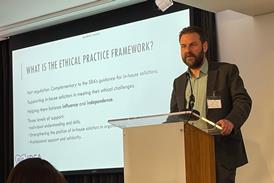The move from the now largely extinct fax machine to email happened as recently as 2010. In this fast-evolving digital era, are today’s innovative technologies already on the road to extinction? How will they be replaced and how can you prepare for a future yet to be defined?

Starting a digital journey
With the ever-improving abilities of generative AI, the biggest risk posed by tomorrow’s technology could be simply failing to use it. For both law firms and clients, it can be difficult to know where to start. Ask yourself: What problems am I trying to solve? How can I streamline my way of working to make it easier, more efficient, accessible, better? Are my aspirations quick-win innovations or revolutionary transformation? At ICC, our dispute resolution leadership, thinktanks and experts are engaging with these questions.
Capabilities and transformation
After identifying areas for improvement, the next stage is to build technical capacity. Today’s legal professionals must be sufficiently literate in emerging technologies to recognise genuine value-add opportunities and articulate business requirements in ways that allow developers to find new solutions to old problems.
Case management: ICC recently launched a new version of its digital case management platform. ICC Case Connect, now powered by Opus 2, enhances ICC’s dispute resolution services with integrated, efficient digital tools. Case management is easier and clearer. Highlights include e-filing and e-payment of filing fees, secure document management and dedicated party portals.
Document management and review: Huge efficiency savings can be made relating to the use of documents and document management. In the past, junior staff spent long nights photocopying hearing bundles and schedules of documents, drafting chronologies and reviewing reams of files during document production. These can now all be produced and filed electronically, creating fully word-searchable files. They can also be fed into tools to digest, prepare summaries, find relevant case law, and propose questions for examination or cross-examination. Advanced tools may even suggest a probability of success.
E-disclosure technology has obvious benefits – a machine can read, understand and review documents much faster than humans. Some AI tools report automated document analysis of more than 90% accuracy. Searches can be conducted on mass documents to extract keywords, identify relevant documents, recognise patterns and conduct sentiment analysis.
Hearings: Virtual and hybrid hearings have become commonplace. Video conferencing, document sharing and electronic hearing bundles remove the need for travel. Transcripts of virtual hearings can be summarised in seconds. Not only can a machine provide a near-perfect instant translation, it can even imitate your voice in the other language, bringing a more personal touch to communications.
Research and case preparation: AI chatbot tools can help with legal research by identifying relevant case law or legal commentary. It can then summarise the results, highlighting key features such as the main points in dispute or law referred to in the decision. AI tools can prepare memos on specific issues of law or arbitration in seconds.
Understanding risks
The potential for cost reduction, time savings and error detection through using technology in arbitration are undisputed, but each technology brings its own obstacles.
Safety and maintaining confidentiality remain a high priority. When choosing a technology, ask: What happens to the data? Who will own it? Where is it kept? Who could have access to it and for what use? Do I need to be aware of any data protection regulations?
How AI tools should be used in an arbitration, including disclosure of use, is far from settled. While some bodies have published guidelines, and the EU AI Act regulates the use of certain AI by arbitral tribunals, there are no universal standards regulating AI application in international arbitration. Parties and arbitral tribunals are encouraged to discuss AI and agree on a protocol for its use early in proceedings. Through its task force on the use of AI in international dispute resolution, the ICC Commission on Arbitration and ADR (ICC’s thinktank comprised of over 1,400 members from more than 100 countries) is considering the key issues.
Risk of bias, error or AI being tainted by external information or hallucinations are well-reported. These risks can be minimised by using closed or bespoke models, but their price can be prohibitive. The key takeaway should remain that these are tools, not a replacement for a lawyer. All output should be checked or you risk being the next lawyer a court finds to have quoted non-existent case law.
With these technologies, the way legal services are provided will change. Tasks traditionally undertaken by paralegals, researchers and legal translators will become more capable of completion by machines. Professionals must be agile in their business strategies, ready to adapt, and continuously learn new technologies, processes, and training.
The next evolution?
In the short-term, we can expect more technologies aimed at automation of manual tasks and simplifying workflows, but being overtaken by robots remains science fiction. A great arbitration practitioner is more than a machine, they need human skills: creativity, persuasiveness, empathy, critical judgement and human relationships with human clients.
Learning from history, the technology we are amazed by today will be extinct tomorrow. As arbitration practitioners, we need to be ready to embrace the changes ahead or risk becoming fossils ourselves.
Ashleigh Brocchieri is expert counsel at the ICC International Court of Arbitration































1 Reader's comment